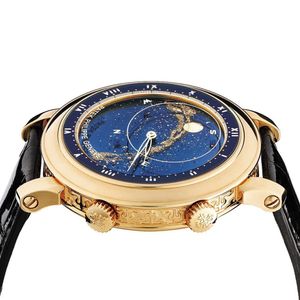Patek Philippe Celestial Ref 5102J-001 Watch
Patek Philippe Celestial Ref 5102J-001. An 18ct gold astronomical wristwatch with sky chart, phases and position of the moon and time of meridian passage of Sirius and the moon, circa 2009. Dial blue, inner blue bezel with silvered Roman numerals, the sapphire crystal glass with silvered ellipse framing the visible sky (marked out with the cardinal points), planisphere of the Northern Hemisphere rotates counter-clockwise above the dial, skeletonised white-lacquered feuille hands, circular case band finely decorated with halved. Calatrava crosses, crown at 2 o'clock for time setting, crown at 4 o'clock for adjusting the planisphere by turning to one direction and in the other direction to correct the angular position and moon phases. Calibre Cal. 240 LU CL automatic movement stamped with the Geneva seal, 45 jewels, 22ct gold mini-rotor engraved with the Calatrava cross. Movement number 3580271. Case 18ct gold, screw-down sapphire crystal case back. Case number 4464141. Closure black leather Patek Philippe strap with 18ct gold Patek Philippe buckle. Dimensions 43 mm diameter. Signed case, dial and movement. Accessories Accompanied by a Patek Philippe Certificate of Origin, papers, presentation folder, cardboard travel box and facsimile J Farren-Price invoice. . Provenance: Important Jewels, Sotheby's Australia, 8 August 2018, lot 175, illustrated. Private Collection, Sydney, acquired from the above. OTHER NOTES. In 2002 Patek Philippe released the Celestial (Ref. 5102) which is considered one of the most significant and unusual horological complications ever developed. A remarkable rendition of the Northern Hemisphere's celestial chart is fitted dynamically upon the wrist for the first time. The celestial chart rotates counterclockwise, showing the angular progression of stars relative to the meridian passage of Sirius. At the same time, the meridian passage and phases of the moon can be seen. 25 trillion (25,000,000,000,000) ratio combinations were researched by Patek Philippe to determine an astonishing degree of accuracy for all the Ref. 5102's displays.
You must be a subscriber, and be logged in to view price and dealer details.
Subscribe Now to view actual auction price for this item
When you subscribe, you have the option of setting the currency in which to display prices to $Au, $US, $NZ or Stg.
This item has been sold, and the description, image and price are for reference purposes only.
- Movement - The technical name for the workings of a clock or watch, and does not include the dial or case.
- Moon Dial - If we imagine life in the 17th century, the only source of ascertaining the time of day or night would have been the local church or municipal clock striking every quarter hour, and able to be heard by all in the village. In England, when longcase clocks became popular and more affordable in the late 17th century, the function of timekeeping and source of time was moved to within the home.
An additional feature on some longcase clocks was to display the phases of the moon, that is the new moon, the full moon and the waning moon over the lunar 29 ½ day cycle. This information was important for farmers for working out cropping schedules; for travellers to know the amount of moonlight on a night they planned to travel; and for those who lived near the sea required knowledge of the tides.
Where included, the moon dial is usually in the form of a disc incorporated into the main dial plate, usually in the arched top section. The lunar cycle starts with the new moon displaying, which is a dark night sky and no man-in-the-moon face being displayed, and then progresses to the full moon face showing on the 15th day of the lunar cycle, and back to no face displaying as the moon wanes. Most lunar dials are partially concealed on each side of their opening in the main dial plate by semi-circular "humps" that allow the painted face to emerge slowly just as the real moon goes out of and back into the earth's shadow.
Nowadays, details of the lunar cycle is published in diaries, almanacs, and newspapers and although some modern longcase clocks are still manufactured with working moon dials, they are more for decoration than for use. - Circa - A Latin term meaning 'about', often used in the antique trade to give an approximate date for the piece, usually considered to be five years on either side of the circa year. Thus, circa 1900 means the piece was made about 1900, probably between 1895 and 1905. The expression is sometimes abbreviated to c.1900.
- Bezel - On a clock or watch, the bezel is the metal frame into which the watch or clock glass is fitted. In clocks, the bezel may include a hinge and a flange, in effect a door to the face of the clock. In jewellery the bezel is a band of metal with a projecting lip that holds the gemstone in its setting.
This item has been included into following indexes:
